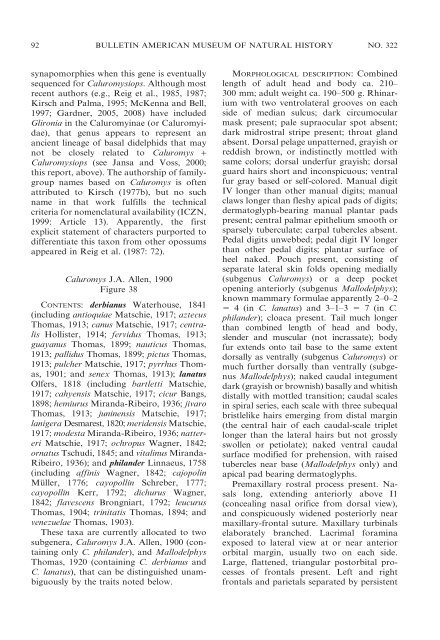phylogenetic relationships and classification of didelphid marsupials ...
phylogenetic relationships and classification of didelphid marsupials ...
phylogenetic relationships and classification of didelphid marsupials ...
Create successful ePaper yourself
Turn your PDF publications into a flip-book with our unique Google optimized e-Paper software.
92 BULLETIN AMERICAN MUSEUM OF NATURAL HISTORY NO. 322<br />
synapomorphies when this gene is eventually<br />
sequenced for Caluromysiops. Although most<br />
recent authors (e.g., Reig et al., 1985, 1987;<br />
Kirsch <strong>and</strong> Palma, 1995; McKenna <strong>and</strong> Bell,<br />
1997; Gardner, 2005, 2008) have included<br />
Glironia in the Caluromyinae (or Caluromyidae),<br />
that genus appears to represent an<br />
ancient lineage <strong>of</strong> basal <strong>didelphid</strong>s that may<br />
not be closely related to Caluromys +<br />
Caluromysiops (see Jansa <strong>and</strong> Voss, 2000;<br />
this report, above). The authorship <strong>of</strong> familygroup<br />
names based on Caluromys is <strong>of</strong>ten<br />
attributed to Kirsch (1977b), but no such<br />
name in that work fulfills the technical<br />
criteria for nomenclatural availability (ICZN,<br />
1999: Article 13). Apparently, the first<br />
explicit statement <strong>of</strong> characters purported to<br />
differentiate this taxon from other opossums<br />
appeared in Reig et al. (1987: 72).<br />
Caluromys J.A. Allen, 1900<br />
Figure 38<br />
CONTENTS: derbianus Waterhouse, 1841<br />
(including antioquiae Matschie, 1917; aztecus<br />
Thomas, 1913; canus Matschie, 1917; centralis<br />
Hollister, 1914; fervidus Thomas, 1913;<br />
guayanus Thomas, 1899; nauticus Thomas,<br />
1913; pallidus Thomas, 1899; pictus Thomas,<br />
1913; pulcher Matschie, 1917; pyrrhus Thomas,<br />
1901; <strong>and</strong> senex Thomas, 1913); lanatus<br />
Olfers, 1818 (including bartletti Matschie,<br />
1917; cahyensis Matschie, 1917; cicur Bangs,<br />
1898; hemiurus Mir<strong>and</strong>a-Ribeiro, 1936; jivaro<br />
Thomas, 1913; juninensis Matschie, 1917;<br />
lanigera Desmarest, 1820; meridensis Matschie,<br />
1917; modesta Mir<strong>and</strong>a-Ribeiro, 1936; nattereri<br />
Matschie, 1917; ochropus Wagner, 1842;<br />
ornatus Tschudi, 1845; <strong>and</strong> vitalinus Mir<strong>and</strong>a-<br />
Ribeiro, 1936); <strong>and</strong> phil<strong>and</strong>er Linnaeus, 1758<br />
(including affinis Wagner, 1842; cajopolin<br />
Müller, 1776; cayopollin Schreber, 1777;<br />
cayopollin Kerr, 1792; dichurus Wagner,<br />
1842; flavescens Brongniart, 1792; leucurus<br />
Thomas, 1904; trinitatis Thomas, 1894; <strong>and</strong><br />
venezuelae Thomas, 1903).<br />
These taxa are currently allocated to two<br />
subgenera, Caluromys J.A. Allen, 1900 (containing<br />
only C. phil<strong>and</strong>er), <strong>and</strong> Mallodelphys<br />
Thomas, 1920 (containing C. derbianus <strong>and</strong><br />
C. lanatus), that can be distinguished unambiguously<br />
by the traits noted below.<br />
MORPHOLOGICAL DESCRIPTION: Combined<br />
length <strong>of</strong> adult head <strong>and</strong> body ca. 210–<br />
300 mm; adult weight ca. 190–500 g. Rhinarium<br />
with two ventrolateral grooves on each<br />
side <strong>of</strong> median sulcus; dark circumocular<br />
mask present; pale supraocular spot absent;<br />
dark midrostral stripe present; throat gl<strong>and</strong><br />
absent. Dorsal pelage unpatterned, grayish or<br />
reddish brown, or indistinctly mottled with<br />
same colors; dorsal underfur grayish; dorsal<br />
guard hairs short <strong>and</strong> inconspicuous; ventral<br />
fur gray based or self-colored. Manual digit<br />
IV longer than other manual digits; manual<br />
claws longer than fleshy apical pads <strong>of</strong> digits;<br />
dermatoglyph-bearing manual plantar pads<br />
present; central palmar epithelium smooth or<br />
sparsely tuberculate; carpal tubercles absent.<br />
Pedal digits unwebbed; pedal digit IV longer<br />
than other pedal digits; plantar surface <strong>of</strong><br />
heel naked. Pouch present, consisting <strong>of</strong><br />
separate lateral skin folds opening medially<br />
(subgenus Caluromys) or a deep pocket<br />
opening anteriorly (subgenus Mallodelphys);<br />
known mammary formulae apparently 2–0–2<br />
5 4 (in C. lanatus) <strong>and</strong> 3–1–3 5 7 (in C.<br />
phil<strong>and</strong>er); cloaca present. Tail much longer<br />
than combined length <strong>of</strong> head <strong>and</strong> body,<br />
slender <strong>and</strong> muscular (not incrassate); body<br />
fur extends onto tail base to the same extent<br />
dorsally as ventrally (subgenus Caluromys) or<br />
much further dorsally than ventrally (subgenus<br />
Mallodelphys); naked caudal integument<br />
dark (grayish or brownish) basally <strong>and</strong> whitish<br />
distally with mottled transition; caudal scales<br />
in spiral series, each scale with three subequal<br />
bristlelike hairs emerging from distal margin<br />
(the central hair <strong>of</strong> each caudal-scale triplet<br />
longer than the lateral hairs but not grossly<br />
swollen or petiolate); naked ventral caudal<br />
surface modified for prehension, with raised<br />
tubercles near base (Mallodelphys only) <strong>and</strong><br />
apical pad bearing dermatoglyphs.<br />
Premaxillary rostral process present. Nasals<br />
long, extending anteriorly above I1<br />
(concealing nasal orifice from dorsal view),<br />
<strong>and</strong> conspicuously widened posteriorly near<br />
maxillary-frontal suture. Maxillary turbinals<br />
elaborately branched. Lacrimal foramina<br />
exposed to lateral view at or near anterior<br />
orbital margin, usually two on each side.<br />
Large, flattened, triangular postorbital processes<br />
<strong>of</strong> frontals present. Left <strong>and</strong> right<br />
frontals <strong>and</strong> parietals separated by persistent

















